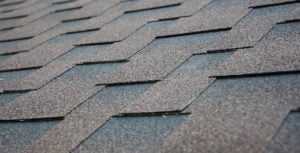Picture this: It’s a dark, stormy night, and you’re curled up on the couch with your family. You can hear the rain pelting against your roof, but you don’t have a care in the world because you know that your home is safe and dry. That feeling of security is priceless, and it all starts with the right type of shingle.
But with so many different types of asphalt shingles, it’s easy to feel overwhelmed. Should you go with the tried-and-true 3-tab shingle or something more modern, like architectural shingles? In this guide, we’ll dive deeply into the world of asphalt shingles and help you choose the perfect type for your home. Let’s get started.
-
Three-tab Shingles
As the name suggests, these shingles are designed with three tabs, or notches, cut into the lower edge of each piece. When the shingles are put on the roof, these tabs give them a unique look and help make a uniform pattern. Three-tab shingles are a popular choice for homeowners and contractors alike for a few reasons.
Advantages
- Cost-effective: They’re less expensive than other roofing materials if you’re on a tight budget. They’re popular, so you know you’re making a sound investment.
- Easy to install: Their simple design makes them relatively easy to install, saving you time and money during construction. And because they’re lightweight, they won’t strain your roof’s underlying structure unnecessarily.
Disadvantages
- Limited warranty: Because of their shorter lifespan, many manufacturers offer limited warranties on three-tab shingles, which may not provide the same level of protection as other types of warranties.
- Vulnerable to wind damage: Three-tab shingles might not be your best bet in windy areas. Why? Well, their lightweight, flat design leaves them vulnerable to the forces of nature.
Architectural Shingles
Roofing shingles, also called “architectural shingles,” are made of a fiberglass mat base covered with asphalt and mineral granules. They get their name from their unique layered construction, which gives them a three-dimensional look and more depth than traditional 3-tab shingles. These shingles come in various shapes, sizes, and colors to suit any home style or aesthetic.
Advantages
- Durability: They are thicker, sturdier, and more durable than your typical 3-tab shingle, meaning they can withstand wind, rain, hail, and anything else Mother Nature throws their way.
- Energy efficiency: We have you covered if you want to save cash here and now. Some types are designed to reflect sunlight, which can help lower your energy bills by reducing heat absorption.
Disadvantages
- Cost: They have a higher price tag than traditional 3-tab shingles. The cost can fluctuate depending on the specific quality and style you opt for.
- Vulnerability to algae growth: Some architectural shingles may be more susceptible to algae growth, which can cause discoloration over time.
Cedar Shingles
Cedar shingles are the perfect combination of natural beauty and durability. They are made from Western Red Cedar, a wood that doesn’t rot, attract insects, or get wet. One of the key characteristics of cedar shingles is their rustic, natural appearance.
Advantages
- Lightweight: They are lightweight and easy to install, making them a popular choice for DIY projects.
- Sustainability: They’re made from renewable resources, so you can rest easy knowing you’re doing your part for the environment. Likewise, shingles can be recycled at the end of their lifespan.
Disadvantages
- Fire risk: They are highly combustible, increasing your fire risk, especially if you live in a wildfire-prone region.
- Availability: It might not be easy to get your hands on. So, if you’re dead set on using them, be prepared to put in the legwork to track down a supplier who carries them.
How Long Do Architectural Shingles Last?
Architectural shingles’ lifespan can depend on various factors. These include shingle quality, installation quality, climate, sunlight, and tree coverage. If you use higher-quality shingles made with better materials and manufacturing processes and have them installed correctly, they can last up to 30 years.
In contrast, lower-quality shingles that are poorly installed or in harsh environments may only last around 15 years. But remember that these are general guidelines, so it’s best to consult a roofing expert to get personalized recommendations based on your specific roof conditions.
Architectural Shingles vs 3 Tab Shingles
Your choice of shingle can make or break your roof replacement project. Take no shortcuts when it comes to quality. Whether you opt for the classic appeal of three-tab shingles, the versatility of architectural shingles, or the natural beauty of cedar shingles, make sure you invest in a high-quality product that will stand the test of time.
And remember, the right roofing company can make all the difference. Choose a trusted, experienced partner that understands your needs and delivers exceptional results. Contact us to help you protect your home for years to come.
FAQs
What Are the Main Types of Asphalt Shingles?
The three primary types of asphalt shingles are:
- 3-Tab Shingles – Affordable, lightweight, and flat in appearance.
- Architectural (Dimensional) Shingles – Thicker, more durable, and have a textured, layered look.
- Luxury (Premium) Shingles – High-end, durable shingles that mimic slate or wood shakes.
What Is the Difference Between 3-Tab and Architectural Shingles?
3-tab shingles are thinner, with a uniform, flat look, while architectural shingles are thicker and have a more dimensional appearance, making them more durable and visually appealing.
Are Luxury Shingles Worth the Investment?
Luxury shingles offer superior durability, aesthetic appeal, and better weather resistance. They are ideal for homeowners looking for a premium look and long-term investment.
How Long Do Asphalt Shingles Last?
- 3-Tab Shingles: 15–25 years
- Architectural Shingles: 25–30 years
- Luxury Shingles: 30–50 years
Which Asphalt Shingles Are Best for Harsh Weather?
Architectural and luxury shingles are better for harsh weather due to their thickness, wind resistance, and impact resistance. Some brands also offer shingles rated for high winds and hail.
Are Asphalt Shingles Energy-Efficient?
Yes, some asphalt shingles are designed with reflective granules to reduce heat absorption, helping improve energy efficiency. Look for "cool roof" shingles for better energy savings.
How Do I Choose the Right Asphalt Shingles for My Home?
Consider factors such as budget, climate, durability, aesthetics, and warranty coverage when choosing shingles. Architectural and luxury shingles provide better long-term value.
Do Asphalt Shingles Require Maintenance?
Minimal maintenance is required, but regular inspections, cleaning debris, and ensuring proper ventilation can extend their lifespan.
Can I Install Asphalt Shingles Myself?
While DIY installation is possible, professional installation ensures proper sealing, alignment, and warranty compliance.


